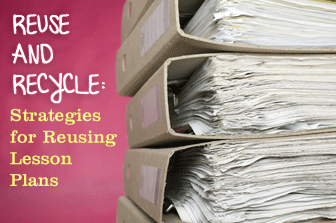
One battle all teachers face is time management. Let’s face it; there is a lot to do in a day—from lesson planning to student management to paperwork and follow-ups.
In addition to that teachers need to keep lessons fresh, exciting and innovative. Use these tips to reuse and recycle your lesson plans and you won’t be drowning in unnecessary prep work.

HOWTO: Reusing Lesson Plans
-
1
Rework It
Sometimes we teachers can get into a rut with our activities and we don’t realize that things might be getting a little bit stale. It is easy to get into habits and when something works it makes it that much easier to stay the course. One way to liven up lesson plans is to occasionally rework how you are setting them up and shift things around. Simple things like changing the order of when you do things can make a difference. If you always find that you are running low on time in certain areas of your lesson plans, this may be another reason to change things up. Try altering your plans so that students don’t always know exactly what to expect. Continuity is a good thing, but so is variety. Some examples are: do a mingling activity right at the beginning of class, have some music playing when they enter the room and create a backwards day where everything they do is the opposite of normal, or call it a review day and students dictate what topics the class covers and when. Another way to rework your plans is to find different ways to review homework that can be used to energize the class. Formulate hands-on activities based on the homework instead of just going through it and correcting it. You can also look at what you are assigning them for homework and see if there are more in-depth activities you could do based on what they have done at home. Incorporating short presentations or speeches is another way to gain some variety and break routines. Project-oriented work gives students renewed goals to work toward, and it will give you an opportunity to try some new ideas.
-
2
Adapt for Different Classes
One of the best lessons you can learn as a teacher is simple. You can do the same activity in all of your classes. The trick is to adapt it based on a few key elements. Take the activity that you used for one class to practice one tense or grammar point and find a way to tweak it and use it for another grammar point in another class. Many activities don’t simply depend on the grammar point itself, so you can take the idea and apply it to other topics. Another way to change-up an activity is to just make it simpler or more difficult based on their level. All students need to practice past tense, so if you have a great activity for beginners take the same activity and add an element of difficulty to it for your more advanced students. You can do this for many of your activities, and you will find that making slight changes creates a more effective activity for the next time you plan to use it.
-
3
Go Online
There are obviously numerous websites out there to help you with ideas for lesson planning. If you often go to the same sites for activities, you might be limiting yourself. Broaden your search and find some new websites to find inspiration. Try finding a few websites that offer different types of worksheets, activity ideas and online resources. Many websites also get wonderful contributions from teachers of things they have created and have decided to share with other teachers. Complex board games, card cut-outs that can be laminated and printable quizzes and worksheets are all good options to be on the lookout for.
-
4
Examine New Themes
Often teachers get accustomed to supplementing a grammar lesson with particular themes or topics. Some of them are very difficult to alter like, for example giving directions to practice prepositions. It’s a very common theme, so why not examine another way in which students could use that same grammar point. Changing the theme from giving directions to moving house would be enough to freshen up an old lesson plan. Look at ways you can incorporate topics that integrate current events, pop culture or socially-relevant material. Provide variety in your lesson plans by devising new ways in which students can practice an old grammar point.
Reusing and recycling lesson plans is a skill that will serve you well throughout your teaching career.
In looking at ways to alter and change routines, you will find yourself becoming more flexible and open to trying new things. Don’t forget to take risks, keep notes on the success of activities, and have the students evaluate your plans and activities.
P.S. If you enjoyed this article, please help spread it by clicking one of those sharing buttons below. And if you are interested in more, you should follow our Facebook page where we share more about creative, non-boring ways to teach English.







